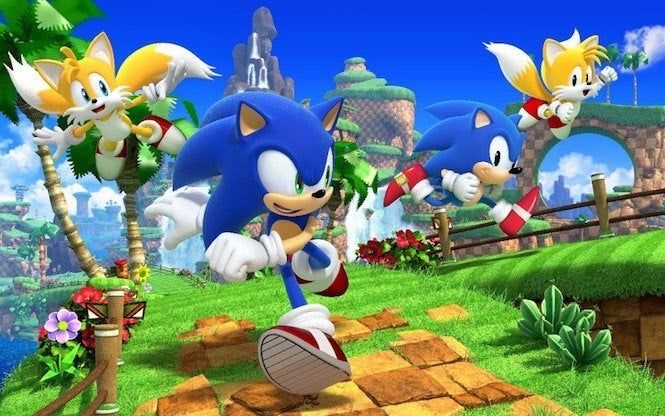Create a free profile to get unlimited access to exclusive videos, sweepstakes, and more!
How Sonic the Hedgehog became an innovative technology trailblazer

It's hard to believe that Sonic the Hedgehog is nearly 30 years old. Racing onto the Sega Genesis in 1991, the sprightly hedgehog quickly became a veritable video game icon and new Sega mascot — and a tech trailblazer.
Technological innovation is a fascinating part of Sonic's history, informing the character's evolution over time. During the 16-bit generation, Sega experimented with Genesis add-ons like the moderately successful Sega CD, and the ill-fated 32X. In 1995, It released what was essentially a portable Genesis, the Sega Nomad. The company produced a full-color handheld at a time when Nintendo's Game Boy still rocked a dot-matrix display. Its cable-based content delivery service, the Sega Channel, took being a Sega fan to an entirely new level. Each innovation met with mixed success, but Sega surged forward, taking its flagship franchise in different technological directions along the way.
So before you head out and see this weekend's feature film, lace up your running shoes and snag some golden rings while we bring you up to speed on the technological history of Sonic the Hedgehog.
THE 8-BIT INCARNATION IS AN AMAZING FEAT OF TECHNOLOGY
The original Sonic the Hedgehog was a massive hit, inspiring not only a sequel but an 8-bit version for both the Sega Master System and Game Gear handheld. The game isn't a port of the Genesis title — it's a completely new version of the game, maintaining the spirit of the original on less advanced hardware. With some oversight from Sonic Team, Yuzo Koshiro's Ancient Corp built their own version of Sonic the Hedgehog from the ground up. Koshiro supervised the development and musical direction of the 8-bit game. Using a programmable sound generator, he converted themes from Genesis Sonic to 8-bit form and composed a few original pieces for the title.
While it lacked the speed of the Genesis game due to hardware limitations, there was a larger focus on exploration and platforming. The game used the same story and similar gameplay elements, but featured completely different levels, layouts, and altered boss battles. Two new zones — the Bridge (containing an auto-scroll stage) and the Jungle (featuring an entirely vertical stage) were exclusive to the 8-bit version. Due to frame rate limitations on both systems, rings no longer bounced around the screen, so Sonic lost them forever once he sustained damage. Some items appeared in different locations on each system as well, to maximize the space available while keeping the experience functional.
The Sega Master System and Game Gear versions were essentially the same game, with a few key differences. The Game Gear modified some boss battles to accommodate the speed and resolution of the system. While the Master System version appears brighter and more colorful, the Game Gear version has a higher color palette despite its lower resolution.
Most interesting are the warning signs present in the Green Hill Zone of the Game Gear version. It turns out the signs were there to help prevent Sonic from going too fast because the higher speeds and narrow screen of the unit apparently caused problems with the game.
A different company, Aspect Co., developed the 8-bit version of Sonic 2. It was vastly different than its Genesis counterpart with gameplay similar to its 8-bit predecessor. There's a hang gliding stage that pushes the handheld to its limits, while the game tried to ramp up the speed in several new stages. Aspect Co. released an original sequel, Sonic Chaos, for both Master System and Game Gear. Many 8-bit spin-off titles — like Tails' Adventure and Sonic Triple Trouble — followed, but none of them pushed the system nearly as much as the original.
Sonic 2 introduced many series staples aside from Tails. It brought us the legendary spin dash technique that appears in every subsequent 2D Sonic title to date. Even the recent Sega Ages release of Sonic the Hedgehog retroactively adds the technique to enhance the game on newer technology.
SONIC AND KNUCKLES GET "LOCKED-ON" TO A LASTING FRIENDSHIP
With the success of the franchise well underway and the 8-bit era fading, a new technological innovation occurred with Sonic 3. In 1994, Sega found itself in a bizarre situation: a previous commitment to a promotion involving McDonald's Happy Meal toys combined with a game that was too large to fit onto a single cart led the ambitious Sonic 3 to become two games instead of one. The developers cut the game in half, releasing Sonic 3 in February 1994, with a follow-up scheduled for October.
Sega programmed Sonic & Knuckles to be the second half of Sonic 3. The game cartridge had a slot on top where players could lock in their Sonic 3 cartridge, expanding Sonic & Knuckles into the full game it was intended to be from the start. Special circuitry inside the cart installed combined the game ROMs from each title into one address space. Most of the code came from Sonic & Knuckles' cartridge, but by virtue of the lock-on technology, the game could reach into and use assets from Sonic 3.
The lock-on technology allowed some other interesting features when you plugged in Sonic 1 or Sonic 2 to the Sonic & Knuckles cart. The latter opened up the entirety of Sonic 2 to the character of Knuckles while the former brought up an error screen, but did allow players to access the blue sphere bonus stages from Sonic 3 by pushing the A, B, or C buttons. Serving its purpose, the technology fell into disuse but stands as a testament to Sonic Team's dedication and ability to overcome the limitations of its hardware at the time.
SONIC ENTERS THE THIRD DIMENSION
Sonic made a successful transition into 3D with Sonic Adventure on the Sega Dreamcast. The game incorporated the Dreamcast's visual memory unit (VMU) — a detachable memory card with controls and an LCD screen — with a mini-game called Chao Adventure. Players could train their Chao in the VMU, then transfer it back for use in Sonic Adventure.
Though popular and well-received, Adventure wasn't the first attempt to transition the character into 3D. First, Sonic 3 experimented with isometric bonus stages. Then came Sonic 3D Blast, an isometric platformer with 3D pre-rendering in parts of the game. Finally, there was the ambitious Sonic X-treme, which Game Informer suggests contributed to Sonic's difficult move to 3D. The development cycle suffered rocky and numerous setbacks that ultimately led to the game's cancellation.
Later 3D games introduced various gimmicks, but few of them demonstrate the same level of innovation of earlier titles. A few of them suffer from bugs, glitching, and design problems.
After the Dreamcast, Sega moved away from hardware to focus on software development. Sega soon developed the "Hedgehog Engine" for their 3D games. Ostensibly a graphics engine, it allowed Sonic games to produce CGI-quality graphics on the Wii U, PC, PlayStation 3, and Xbox 360 (but not the Wii or PlayStation 2). The engine uses Global Illumination to make a single light source reflect off every item in a scene. Part of the engine, Light Field, seamlessly blends characters into their environments. Both Sonic Unleashed and Sonic: Lost World used the engine.
Sonic Generations combined classic and modern Sonic in a mix of 2.5D classic stages and 3D modern stages using the Hedgehog Engine. The 3DS version wasn't compatible, however, but both Generations and Sonic: The Lost World took advantage of the system's stereoscopic 3D effect, which works by using a parallax barrier to create the illusion of 3D.
A different kind of 3D Sonic appeared in 2013 on the Nintendo 3DS, when Sega gave the original Sonic the Hedgehog a stereoscopic 3D makeover. It's similar to viewing a Real-D 3D film at the cinema, only instead of passively viewing content, you interact directly with the on-screen action, while controlling the depth of the 3D effect. Sega later used the effect on several later 3DS Genesis classics (including Sonic 2).
More recently, Sonic Forces took 3D Sonic in a promising direction. Aside from its original character generator, it uses the new Hedgehog Engine 2. The new engine improves shadows, creates realistic lighting, and increases the game's speed without reducing its quality.
BECOMING A SONIC MANIAC
In 2017, Sega gave Sonic fans a pleasant surprise in the form of the brand new 2D, retro-style Sonic Mania. Running at 60 FPS with pixel-perfect graphics, the game provides a mix of new and re-imagined zones with five playable characters.
A few well-known Sonic fans worked tirelessly on the game, many of whom established themselves as talented developers in the Sonic fan game community years prior to Mania's development. One of them, Christian Whitehead, built the Retro Engine upon which Sonic Mania runs. Whitehead's love of 2D Sonic, talent, and skill became apparent with his 2008 fan game, Retro Sonic, and it's no surprise that he was instrumental in revitalizing 2D Sonic for the modern world. Sega hired Whitehead in 2009 to port Sonic CD to the iPhone and other platforms. He rebuilt the game using his retro engine, to great success.
Another developer, Simon Thomley of Headcanon studios, worked with Whitehead to create other 2D Sonic ports and they eventually teamed up to make Sonic Mania. Building the game on modern software made it more like a continuation of the 16 and 32-bit era games, a natural next step in the evolution of the series.
The Retro Engine itself focuses on rasterizing, mode 7 effects, and other features of retro consoles while allowing for modern amenities such as widescreen, better soundtracks, and higher frame rates.
Sonic Mania also incorporates pinball mechanics and elements (like bumpers) into its game design, paying homage to the use of similar mechanics in earlier games. Sonic Mania is addictive, loaded with Sonic Easter eggs, introduces new characters, and will keep you busy for some time.
SONIC'S LEGACY AND BEYOND
Though he's had his ups and downs, Sonic's future looks bright. On top of his new feature film, Sega recently announced an upcoming main series Sonic game is in the works. Will it use the Hedgehog Engine 2 as a graphical base and continue in the vein of Sonic Forces? Maybe there's a place in Sonic's future for a Sonic Mania follow-up showcasing more of what the Retro Engine can do.
Perhaps it'll go in another direction and use augmented or virtual reality to enhance graphics and gameplay. Someone already made a VR version of Green Hill Zone. How long will it be before Sega produces a full VR Sonic title? The world needs a VR Sonic game or two.
Regardless of the form the technology takes, it will be interesting to see what comes next for Sonic as he continues to run toward technological innovation across a variety of media and formats.



























